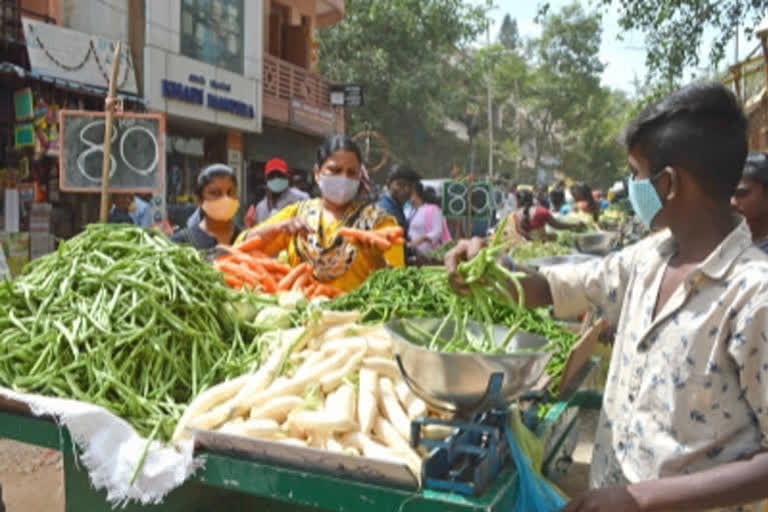New Delhi: In twin blows for the economy, industrial production remained muted for the third straight month in November 2021 while retail inflation rose to a six-month of 5.59 per cent in December.
The Index of Industrial Production (IIP) grew by 1.4 per cent in November as most components like manufacturing, electricity, mining, primary goods, and consumer durables witnessed a slowdown, according to data released by the National Statistical Office (NSO) on Wednesday.
This is on the base of a decline of 1.7 per cent in November 2020 and before the new COVID variant started impacting economic activity.
IIP growth was lower than the 4 per cent expansion recorded in the previous month but was better than a 1.6 per cent contraction seen in November 2020.
Separately, rising prices of kitchen staples pushed retail inflation, or rate of price increase, to 5.59 per cent in December 2021, bringing it close to the upper band of Reserve Bank's comfort zone.
The consumer price index (CPI) based retail inflation was 4.91 per cent in the previous month and 4.59 per cent in December 2020.
The RBI, which mainly factors in the CPI-based retail inflation while arriving at its bi-monthly monetary policy, has been tasked by the government to keep the inflation at 4 per cent with margin of 2 per cent on either side or in the range of 2-6 per cent.
Core inflation continues to be elevated and estimated at 6.2 per cent for December 2021, almost at similar levels as in the previous month.
The data is crucial as this was the last metric before the interest-rate setting Monetary Policy Committee (MPC) meets next month.
Retail inflation has been on the rise since October 2021. In July, the rate of price rise was 5.59 per cent before slowing down in the subsequent two months but it started to move up again from October.
"The combination of weakening growth, in-line inflation and Omicron fears may potentially delay the monetary policy normalization in India. The Union Budget is the only Big event before the next MPC. "Though a reverse repo rate hike is still on the table in February, it may be postponed to April as well," said Nikhil Gupta, Chief Economist at Motilal Oswal Financial Services Ltd.
Also Read: Inflation, Omicron major risks to Indian economy: RBI
Aditi Nayar, chief economist at Icra, said the increase in CPI inflation in December 2021 relative to the previous month was primarily led by food and beverages, and clothing and footwear.
There was a welcome moderation in the prints for fuel and light, and pan, tobacco etc amidst a mild dip in miscellaneous items and housing, she said.
"Overall, we expect the headline CPI inflation to range between 5.7-6 per cent in Q4 FY2022, as compared to the MPC's forecast of 5.7 per cent.
"While the CPI inflation has hardened sharply between November and December 2021, the uncertainty triggered by the third wave is sure to take precedence when the MPC meets next month. We now see a negligible likelihood of a change in stance or reverse repo hike in the February 2022 policy review," Nayar said.
With a higher inflation target, the MPC can choose to prioritise growth revival for much longer than other major central banks, for many of whom inflation control has become a pressing policy focus, she added.
As per the data released by NSO, food inflation was at 4.05 per cent in December 2021 compared to 1.87 per cent in the preceding month.
In the food basket, the inflation was on the higher side in 'cereals and products', eggs, 'milk and products', spices, and 'prepared meals, snacks and sweets' over the preceding month.
However, the rate of price rise was slower in case of vegetables, fruits, and 'oil and fats' compared to November 2021.
In the 'fuel and light' category, though the inflation softened from a month ago, it remained elevated at 10.95 per cent during the month. It was 13.35 per cent in November 2021.
The RBI expects the inflation print to be somewhat higher over the rest of the year as base effects turn adverse.
According to the RBI, it is expected that headline inflation will peak in the fourth quarter of the current fiscal and soften thereafter.
According to NSO, the manufacturing sector, which constitutes 77.63 per cent of the IIP, grew 0.9 per cent in November, while mining sector output rose 5 per cent and power generation increased 2.1 per cent.
The factory output had recorded double-digit growth between May and August 2021 before slipping to 3.3 per cent in September and 4 per cent in the month thereafter, mainly due to the waning low base effect.
PTI



